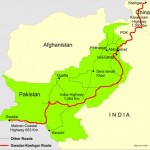IDR Blog
China-India Relations: What is the Role of Third Parties?
Despite the intensification of high-level interactions between China and India in recent years, the current situation can at best be described as complex and sensitive. The bilateral relationship is quite complicated by itself, and ‘third-party actors’ are adding to the complexity – that is to say China and India’s bilateral and multilateral ties with other countries are beginning to influence the bilateral relationship. Addressing these additional concerns and isolating bilateral should therefore be a priority for both sides.
Doubtlessly, 2017 was a tough year for Sino-Indian relations. It witnessed the prolonged Doklam military standoff and intensifying strategic competition between two sides. Although the border crisis has temporarily subsided, the bilateral ties seem very hard to normalise, in particular the broken strategic balance. This means the two countries rarely mention their so called strategic partnership based on common strategic interests and relevant cooperation in public. Public talk of strategic competition in both the Asia-Pacific and the Indian Ocean has become far more salient.
China and India have different perceptions on current unstable relations. Indian strategists insist that it is Chinese strategic behaviour that destroys the status quo. These include China’s Belt and Road Initiative (BRI), a growing presence in South Asia and the Indian Ocean region, blocking of India’s entry to the Nuclear Suppliers Group (NSG), thwarting a bid to get Jaish-e-Mohammad (JeM) chief Masood Azhar declared as an UN-designated terrorist. Chinese strategists think that the Indian side should take the responsibility for unstable ties. Specifically they point to Indian leaders visiting disputed border areas, India’s troop surge along that border, tacit approval of the Dalai lama’s activities in the disputed area, reviving the ‘Quad’ alliance among India, Japan, Australia and the US, to name but a few. Indeed, a number of issues and factors have contributed to the instability in the relationship and each side can take what they need to justify their arguments.
Bilateral issues aside, equal attention needs to be focused on the role of third parties affecting the bilateral relationship. This is particularly important as it complicates the problem set and enables outside control, be it active or passive, of what should be a relationship decided bilaterally between the two capitals. From a Chinese point of view, the big third party problems seem to be the US, Japan and Australia. These actors undoubtedly hope to make use of the contradictions and differences between China and India and seek their own best interests in the Indo-Pacific region and forcefully advocate for the revived ‘Quad’, a strategic alliance designed to have a negative impact on China. From the Indian point of view, Pakistan is the obvious third party irritant.
Surprisingly, however, newer and smaller actors have emerged as having a negative influence on China-India ties. These include Nepal, Bhutan, Maldives, Sri Lanka, Bangladesh and Myanmar. All these countries act according to their own national interest and have no urge to interfere in the ties between the two big powers in Asia. However their actions, even their domestic elections, may have serious consequences for China-Indian relations. The problem is that China probably believes that the development of normal relations with these countries will not harm India’s interests and may indeed intensify China-India-third country cooperation. India however does not share this view. For Indian strategists, this growing Chinese influence, to some extent, constitutes a threat to India. In this context, it is easy to understand the escalated competition ensuing from the actions of these third parties, as could be seen during the unfolding Maldives crisis.
A negative news cycle is another problem. This casts actions that may not have a China-India angle in them as either a victory of ‘pro-India’ forces or ‘pro-China’ forces, ignoring the fact that these are not Indian or Chinese puppets but rather sovereign states with their own domestic problems. This kind of reporting frequently and demonstrably results in an upsurge of nationalism in both sides creating action traps for the respective leaderships, where compromise or even a basic explanation of positions to the satisfaction of the other is seen as retreat. Needless to say, foreign media, yet another third factor, actively fuels this speculation and highlights the contradictions and rivalries between the two countries.
Given how crucial this bilateral relationship is to the future of Asia, it is important to acknowledge the role of third parties and reduce their salience in bilateral ties, failing which bilateral issues should be identified, isolated, and restricted to a serious and sustained engagement at the highest level. This could possible take the shape of a systematic ‘two-plus-two’ dialogue mechanism between their foreign and defence ministers with a clear stating of positions away from the public gaze. The leaders of the two countries will be meeting frequently enough in 2018; the first of these being the Shanghai Cooperation Organisation (SCO) Summit in June. During this, it would be useful if the leaders thrashed out such a mechanism.
Courtesy: http://www.ipcs.org/comm_select.php?articleNo=5450




